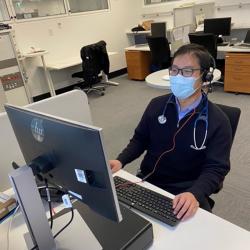“It’s a really good thing to do and it can really be effective, but it’s not the be all and end all”: Using telehealth for palliative care

During the COVID-19-related lockdowns, healthcare providers in Australia and Aotearoa New Zealand had to swiftly pivot to telehealth consultations to minimise face-to-face interactions. This change enabled palliative care clinicians to provide ongoing care for patients. For traditionally high-touch services, however, such a transition also posed unique clinical and ethical challenges. Using phone calls, and, to a lesser extent video calls, to review patients and families was a regular practice for many palliative care teams, but the scale and extent to which they used telehealth during the lockdowns was unprecedented. Tapping into clinicians’ experiences of navigating telehealth during this challenging time provided an important opportunity to explore the dynamics of such clinician-patient and family interactions and models of care.
With the support of a Health Research Council New Zealand (HRCNZ) activation grant, we formed a collaboration with researchers from the Cognitive and Neurological Disorders Symptom Node Subcommittee (CaND SNSC) of the Palliative Care Clinical Studies Collaborative (PaCCSC) and Cancer Symptom Trials (CST), University of Technology Sydney, Dr Katherine Bloomfield and Dr Aileen Collier (co-leads) from the Faculty of Medicine and Health Sciences, University of Auckland, and Dr William E Rosa from Memorial Sloan Kettering (MSK) Cancer Center, New York, who leads comparative work in the USA. Using Zoom, our team interviewed twenty-one clinicians from different disciplines across Australia and Aotearoa New Zealand who provided specialist or generalist palliative care via telehealth.
Some preliminary findings of this qualitative study are as follows:
In the initial stages of implementing telehealth, some services adopted hybrid systems where nurses or other members of the multidisciplinary team visited patients while physicians dialled in for the consultation. Having overcome the initial challenges of familiarising themselves with new technologies, some clinicians were positive about using telehealth to expand their reach. Without the hassle of commuting, they could now optimise their time and ‘visit’ patients more often. When telehealth is adopted more widely, this could significantly benefit patients in far-flung rural areas.
Enthusiastic about telehealth’s potential to overcome barriers of distance and access, one clinician said:
I can only physically, in person, reach so far, but if I can touch more people or spread my skills and knowledge to further places by having virtual consults, why limit myself to [working] locally? You could possibly do it nationally or even internationally if need be.
Tasked with meeting patients through a screen, over time, clinicians devised innovative ways to communicate effectively with patients and families, making them feel more connected. In the absence of rich visual and physical cues, clinicians improvised by asking more detailed questions to gain information or asking patients into giving them a virtual tour of their homes. While the inability to conduct detailed physical examinations virtually, posed an obvious challenge, some clinicians sought to overcome this drawback by co-opting patients and their family members to perform physical assessments ordinarily carried out by a clinician. As nurses and physicians drew on their clinical experience and intuition to develop their own techniques to work effectively with telehealth systems, there is scope to collect these insights more systematically and potentially incorporate them into educating and supporting clinicians in managing virtual consultations.
In addition to enabling clinicians to streamline their work and hold more consultations, they reported how telehealth supported family members. For example, how, in the absence of the limitations of physical presence, family members in different countries and time zones were able to join virtual consults and take a more active role in providing advocacy and emotional support for their loved ones.

Dr Wei Lee conducting a telehealth consultation
While telehealth can help build a wider caring community around the person and their family, virtual communication also raised concerns in clinicians about the security of patients’ medical data and privacy on calls. Further, even as virtual consults can make palliative care accessible to more patients, not everyone may benefit equally from this technological shift. Clinicians were more hesitant to conduct virtual consults with older people who might not be as comfortable with or have access to technology, those with cognitive difficulties, and/or those with language barriers. Initiating discussions about these challenges in implementing telehealth for all patients can help clinicians share their experiences and work collaboratively to address the needs of different groups of patients.
These discussions, spanning niggling tech issues to deeply vexing ethical and patient safety challenges of providing palliative and end-of-life care virtually, highlight the importance of having organisational guidelines in helping clinicians to navigate the moral and clinical dilemmas of choosing between virtual consults and face-to-face visits. With telehealth poised to become a standard part of palliative care provision, we need to engage reflexively with the subtle and other more perceptible shifts it brings in the relational space between clinicians, patients and families, and wider informal as well as professional palliative care networks. Sustained research that draws on patient and family experiences in a range of settings, and currently underserved populations, would generate further insights on the potential benefits of this technology and practice and policy considerations to make safe high-quality palliative care accessible to all.
Acknowledgments
We thank all participants, the HRCNZ for funding the study, Dr Craig Sinclair for his contribution to the study design and Linda Brown, National Manager, PaCCSC/CST.
This article was originally published in PALLIUM, the Palliative Care NSW newsletter.

